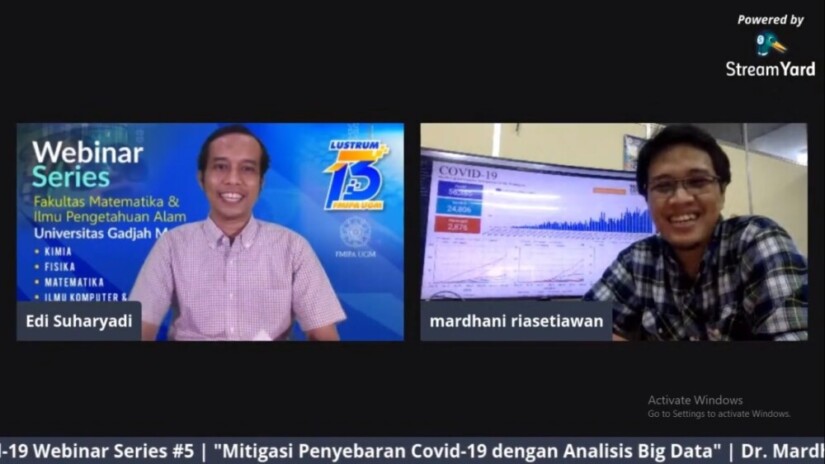
Faculty of Mathematics and Natural Sciences UGM organized the 5th Covid-19 Webinar Series on Thursday (2/7) afternoon. Just like the previous series, this online seminar raised the topic of research and innovation for the handling of Covid-19. While the theme built for the series this time entitled “Mitigation of Covid-19 Distribution with Big Data Analysis”.
Dr. Mardhani Riasetiawan, M.T, Head of the UGM Computer and Networking System Laboratory, explained that the big data project that he had started is initially caused by his unrest since February this year. At that time, he said many countries had claimed positive cases that occurred in their respective regions. However, during that day, Indonesia remained silent, until finally the first case claim was announced around March 13, 2020.
On his remarks, this condition made himself as a genuinely data researcher scrutinizing. He stated that it could be a case in Indonesia, such as the iceberg phenomenon. “I think we might be waiting for positive numbers every day in the media, but below there is a collection of suspects who are waiting for the time to surface to be positively announced,” explained the lecturer in the Department of Computer Science and Electronics FMIPA UGM.
From that side, finally, Mardhani initiated a team to record the Covid-19 case in Indonesia. The group he called the Covid-19 Response Team. He was choosing the name to get as many volunteers as possible. It was sweet fruit because it had not even opened two days, volunteers who registered had reached around 200 people. Now there are about 439 volunteers joined.
He divided the number of people into several task divisions. The division is the beta team in charge of collecting and verifying data. Then there is the data scientist team, engineering team, and campaign team.
In developing this data bid, he claimed to be inspired by global institutions, such as John Hopkins, World O Meter, WHO, Google, and others. “So, we can make a lot of examples for processing and compiling this data,” he explained.
While the process of data collection took from the data collected from government, global, news portals, social media, and crowd persona data, next, the collected data extracted for later processing and display in the form of visualization on the dashboard accessed on the site covid19.gamabox.id.
Initially, he and the team only used a private laboratory. That is because there was limited access to laboratories on campus at that time. Therefore, he collaborated with several start-ups at that time, such as Co-Kawal Escort 19 and Covid-19 Response. However, now the laboratory access has been restored, and it has also received assistance from Ristekdikti / BRIN and LPDP. “This project subsidized for national research in the Covid consortium,” he said.
Mardhani stated his orientation when building big data was for the future. He reckoned that the public did not have any awareness regarding the data from Covid-19, so the spread of the case continued to increase to reach one thousand per day as it is now.
“Not only the community, but the government has also made a blunder. The increase to one thousand positive cases per day occurred two weeks after the government relaxed the PSBB, even though the number of cases was also not in the point that was decreasing at that time. At that time, there was also another variable which was the moment of Eid. The public became a little weak awareness of the pandemic at that moment,” he said.
Mardhani hopes that in the future, this data awareness will become something embedded in the community. Not only that, but he also hoped that the government also made it as a foundation in making policy. Thus the innovations that are present are not only in the context of research and development of data technology alone. However, it is also a social order or data and technology-based society in the future.
“From the data, we have gathered, there were variations in the distribution of Covid-19 in various regions. This fact means there is also variation in public awareness and governance in handling Covid-19. Based on this data, the community and the government can better reflect the most urgent needs. I hope this will be input for handling and handling Covid-19,” he concluded.
Author: Hakam
Translator: Natasa A

